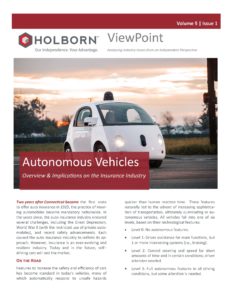Two years after Connecticut became the first state to offer auto insurance in 1925, the practice of insuring automobiles became mandatory nationwide. In the years since, the auto insurance industry endured several challenges, including the Great Depression, World War II (with the restricted use of private automobiles), and recent safety advancements. Each caused the auto insurance industry to rethink its approach. However, insurance is an ever-evolving and resilient industry. Today and in the future, self–driving cars will test the market.
On the Road
Features to increase the safety and efficiency of cars has become standard in today’s vehicles, many of which automatically respond to unsafe hazards quicker than human reaction time. These features naturally led to the advent of increasing sophistication of transportation, ultimately culminating in autonomous vehicles. All vehicles fall into one of six levels, based on their technological features:
- Level 0: No autonomous features.
- Level 1: Driver assistance for main functions, but 1 or more intervening systems (i.e., braking).
- Level 2: Control steering and speed for short amounts of time and in certain conditions; driver attention needed.
- Level 3: Full autonomous features in all driving conditions, but some attention is needed.
- Level 4: Only entry of destination needed by driver; if systems fail, the car safely stops and driver can take over.
- Level 5: No human attention needed and not intended to be actively driven—largely still in development.
Predictions vary as to how quickly these vehicles will populate the roads. Mordor Intelligence anticipates 10 million active self-driving cars (Level 3/4) by 2020 worldwide, together with another 250 million smart cars—vehicles connected to high-tech networks. By 2030, the prediction is 20.8 million autonomous vehicles in the U.S. That being said, auto manufacturers tend to focus on Level 4 technology, where some level of control is still possible.
General Motors is investing in self-driving cars, with the expectation of rolling out these vehicles as part of a ride-sharing partnership with Lyft. In 2016, GM invested $500Mn in Lyft to collaborate the use of GM autonomous vehicles with their service.
Similarly, Ford hopes to enter the ride-sharing business with a $1Bn investment in Argo AI, a robotics company. Ford has targeted 2021 for the availability of Level 4 vehicles. Rival car companies note similar timelines with varied partnerships and expectations.
Much like the established partnerships between automakers and technology companies, some insurance companies are similarly teaming up with automakers to prepare for these inevitable industry changes.
State Farm is collaborating with Ford and the University of Michigan to create a new self-driving Ford Fusion, with varying high-tech features, such as automatic emergency braking, a Lane-Keeping System, blind spot warning, and parking assistance. The symbiotic relationship will have State Farm sharing claims data and driver behavior statistics with Ford—while, in turn, being at the forefront of understanding the new auto technology and becoming a preferred insurance partner.
Google’s Waymo is similarly developing and testing fully autonomous vehicles in Austin, Atlanta, Detroit, and various locations in California and Arizona. The company worked with various auto manufacturers to test the technology, including Toyota, Lexus, Chrysler, and Jaguar. Waymo One launched in 2018 as an autonomous taxi service in Phoenix. In addition, Waymo is exploring Class 8 trucks (tractor-trailers).
Claims Implications
The National Highway & Transportation Safety Administration (NHTSA) estimates that 94% of automobile related liability claims are caused by human error. With increased autonomy, industry experts anticipate the lower accident frequency, by removing or reducing the influence of human error.
Conversely, claims severity will likely increase due to:
- Higher costs of repair for more sophisticated automobiles;
- Potential judicial, legislative, and social changes influencing jury awards; and
- Legal fees associated with determining at-fault party in accidents (i.e., manufacturers vs. operators).
Read the full report here.

